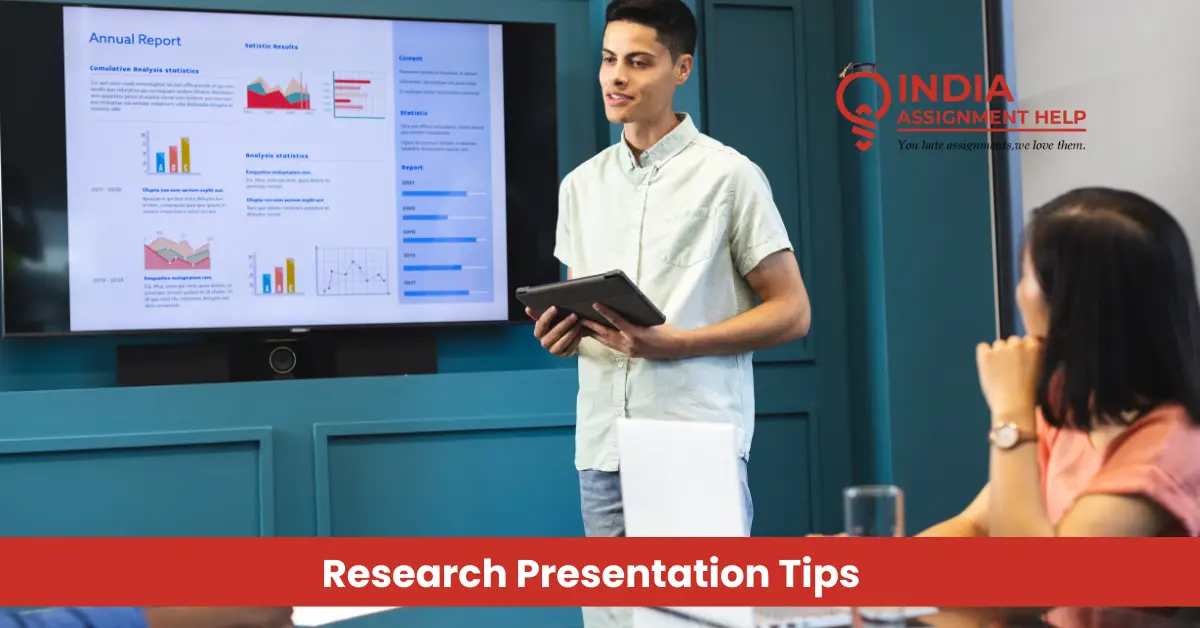Research Presentation Tips Every PhD Student Should Know

Imagine yourself standing before a room full of academics and researchers and presenting your PhD work for the first time ever. Just thinking about it can make you feel both excited and nervous. And the anxiety is completely understandable; your presentation skills can make or break your PhD career. It decides whether or not your research proposal will be approved or if you’ll get funding for your dream research project. Having good presentation skills doesn’t mean you have to memorize certain points; it means you know how to make your audience remember you and your cause.
Over time, with the right techniques and mindset, you can learn to present with confidence and clarity. In this blog, we’ll share some Research presentation tips to guide you on how you can transform nervous energy into powerful storytelling and engage your audience—from start to end.
1. Begin with Your Audience in Mind
Before creating a single slide or writing your speech, ask yourself: Who is going to be in the room? Remember that you’re not presenting for yourself; it’s for your audience. Tailoring your content to suit your audience is the first step you can take in the direction of delivering a meaningful presentation.
Everything, starting from the language you use to the examples or data you show, depends entirely on who your audience is. Presenting before your peers is totally different from pitching to an industry stakeholder. Your language, content density, and examples should align with the audience's familiarity with your topic. So before you start creating, ask yourself
- What do they already know?
- What’s the purpose of your talk—from their perspective?
- Do they prefer straightforward data, or do they expect a more polished and engaging delivery?
For example, If you’re presenting at a conference, you can add a bit of humor; many researchers start with a joke at conferences as it helps their talk stand out in a long day of sessions.
So it’s better to spend 20–30 minutes reflecting on your audience before even opening PowerPoint. The time you invest here sets the tone for everything that follows and sharpens your PhD presentation skills.
2. Structure Your Research as a Story
Humans are wired to remember stories, not statistics. This is why it's so effective to use a simple storytelling framework to shape your presentation: the ABT Method—And, But, Therefore. These research presentation tips have helped a lot of PhD students deliver powerful presentations.
The "And" – Build Your Background
Start by giving your audience context. Set the stage by stringing together basic facts or existing research in your field using “and” statements.
Students learn at different paces AND they get bored when they’re restricted to old textbooks.
This approach provides a baseline of understanding before introducing complexity.
The "But" – Highlight the Problem
Now introduce the challenge your research addresses. This is your conflict, the issue that drives your study.
BUT teachers lack the training and resources to implement adaptive learning systems effectively
When you frame the problem clearly, especially in emotional terms, it captures attention and creates a sense of urgency.
The "Therefore" – Deliver the Solution
Now, present your research as the solution.
THEREFORE, we have developed a modern and easily accessible training model for teachers, which can help them boost their students’s results by 45%.
This ABT method is simple but it is one of the most useful PhD presentation skills. It helps to guide your audience through your narrative and ensures that they follow your logic and connect with your purpose.
3. Emphasize Emotion Over Information
It’s easier to connect to the emotions of a narrator than to the technical details they’re sharing. If you add some emotional elements to the content, they will feel the journey. A good presentation makes the audience care about the problem, your solution, and the impact it could have.
To enhance this emotional impact:
- Use powerful opening and closing lines.
- Reframe the problem in terms of human consequences (e.g., environmental damage, health risks, social impact).
- Use analogies and metaphors to make technical ideas more relatable.
This approach is valuable in the social sciences and humanities, where emotional connection can be more persuasive than numbers. For example, if you’re researching dementia and the impact it has on people and their families, you can include the story of a patient, as it has the power to move people.
4. Boost Energy at the Right Moments
Every good presentation has a rhythm. Typically, it looks like this:
- High energy at the beginning to grab attention.
- Dip in the middle to deliver the main content.
- High energy at the end to leave a lasting impression.
Don’t just start with a bland “Hello, my name is…” Instead, lead with a bold question, surprising fact, or an anecdote related to your research or even a joke, you can even use the same joke at the end as a callback.
5. Repetition is Your Friend
When you’re delivering dense academic content like a Research Presentation, repetition is necessary. You have to identify the key takeaway you want your audience to remember and find ways to repeat it without making it seem like you’re repeating. Confusing, we know but it can be done if you
- Summarize each section briefly.
- Use visual callouts on slides to reinforce key messages.
- Rephrase your conclusion several times with different wording.
If your message is consistent and clear, your audience is more likely to retain it.
6. Turn Nerves into Excitement
It’s normal to feel your heart race before stepping onto the stage. Even the greatest researchers have felt their hands shake when they delivered their first presentation. You just have to shift your mindset and treat nervousness as energy, not a weakness.
We will advise you to start viewing nerves as your body's way of preparing for something important. Prepare your opening line until it becomes second nature. And always remember to practice your presentation out loud.
This mental reframe from “I’m nervous” to “I’m excited” can transform your entire delivery.
7. Use Visuals to Support Your Message
Slides should complement what you're saying, not tell the whole story on their own. One of the most common mistakes in academic research presentations is overcrowding slides with text, data, or journal-style figures.
You can make your visuals effective if you:
- Use high-resolution images
- Include minimal text—preferably three bullet points max
- Highlight only the data you’re discussing. Grey out irrelevant parts of tables or graphs.
- Use larger fonts and clean design to improve readability
Remember, if someone can read your slides and understand the talk without you speaking, you've likely given away too much.
8. Design for the Setting: Online vs. In-Person
The number and style of slides should vary depending on the setting:
- In-person presentations benefit from fewer slides, letting the speaker remain the focal point.
- Online presentations need more visual cues and movement (more slides) to keep viewers engaged on screen.
In either case, your presentation should support a conversational tone. You have to start practicing how to navigate slides naturally and use them as prompts rather than scripts.
9. Redesign Your Graphs for Presentation Use
Graphs that look great in a research paper fail in a presentation. So, no matter how tempted you are, avoid the temptation to copy and paste. Instead:
- Increase font sizes on axis labels and legends.
- Remove unnecessary lines or data points.
- Use color or highlighting to direct attention to what you want the audience to see.
Simplicity in data visualization enhances clarity, reduces confusion, and keeps your audience engaged.
Final Thoughts
You don’t have to be a natural-born speaker to deliver great PhD Research presentations. It’s a learnable skill. With thoughtful preparation, strategic storytelling, emotional intelligence, and learning these PhD presentation skills, you’ll start delivering talks that leave a lasting impression.
So the next time you're getting ready for a presentation, remember: it’s not just about what you say—it’s about how you make your audience feel. If you have a presentation due in a few days and you still haven’t prepared for it, just reach out to us at India Assignment Help, and we’ll help you create something that makes an impression on your audience.





